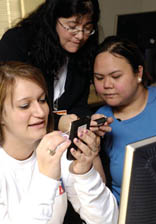By Kelly Brooks-Staub
Photos by Will Kirk

In an effort to better equip tomorrow’s nurses with knowledge of the most advanced health care technologies, the Johns Hopkins University School of Nursing added two new learning technologies to the curriculum this academic year: “Noelle,” a computer-controlled mannequin that simulates pregnancy, labor, and delivery; and Personal Digital Assistants (PDAs) with Micromedex software to provide public health nursing students with clinical decision support.
“With Noelle, we take the students through a labor scenario, teaching them to think on their feet,” explains assistant professor Anne (Nancy) Woods, PhD, CNM. The mannequin allows Woods and assistant professor Elizabeth (Betty) Jordan, DNSc, RNC, to guide small groups of students through a simulation of triage in the obstetrics area; measuring fundal height; using Leopold’s maneuvers to determine the size, position, and presentation of the fetus; interpreting a “real time” fetal monitoring strip; monitoring vital signs for both the mother and the fetus; and developing a care plan.
Woods and Jordan control Noelle and her full-sized infant from a wireless laptop to provide ever-changing conditions that mimic the real-life birthing process, including complications such as a breech birth and shoulder dystocia. If students do not respond to the situation appropriately, both Noelle and the baby can show signs of distress—including turning blue!
“Noelle provides a wonderful complement to the clinical experience,” says Jordan. “The students have the opportunity to think critically about their care in a simulated environment where they have sole responsibility for the ‘patient,’ yet can receive coaching from faculty.”
The realism of the simulation mannequin made an impression on Congressman-elect John P. Sarbanes (D-MD), when he visited the school in December for a demonstration of its heath care information technology initiatives. Sarbanes, who was present for the birth of each of his three children, was surprised by the sensation as he felt the “fetus” in Noelle’s abdomen.
His reaction mirrors that of the nursing students who have used such simulation technologies. “Students get very nervous working with the mannequin,” says instructor Diane S. Aschenbrenner, MS, APRN, BC. “It’s very real for them. Many students will agree that working with the simulation patients is nerve-racking, but they are grateful to get the experience first in a simulation lab instead of across the street at the hospital.”
Johns Hopkins is the first nursing school in the country to use this new model of Noelle and accompanying software. The mannequin is currently utilized in the maternal-newborn course, and will be an integral component of the school’s new midwifery program, slated to begin in Fall 2007.

According to clinical instructor Krysia Hudson, MS, RN, BC, the technology used at the school is more sophisticated than that available at most hospitals. “We teach the optimal,” says Hudson. “And we hope that when our students leave the school, they will propagate the model wherever they work.”
Hudson’s most recent contribution to the school’s educational technology is 25 PDAs to be used by students in their community health clinical rotations. Donated to the school by Thomson Micromedex, the PDAs are often used in state-of-the-art hospital settings, but are also a mobile resource for nurses working in the field. Students can type notes to themselves, create voice recordings, and send their notes and recordings to their instructors via a wireless internet connection.
But the most valuable feature of these handheld devices is the support they provide to public health nurses as they make clinical decisions, Hudson says. Each unit is programmed with Micromedex databases and software, which provide students with current evidence-based clinical knowledge, including both conventional and alternative therapies. The result? Faster, more informed decision-making and better care for patients.
The first two JHUSON student groups began using the PDAs in January when they started working with patients in the East Baltimore communities. The group working with instructor Richard Kimball, MSN, is treating patients with Amyotrophic Lateral Sclerosis (ALS), while students treating patients with AIDS work under the guidance of Kate Lears, MSN, MPH, RN, CIC.
“There are lots of tools available to nurses,” says Hudson. “Using nursing technologies is just an extension of what nurses already do. By exposing the students to these new tools, we hope to open their eyes to a myriad of technological possibilities.”